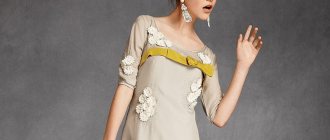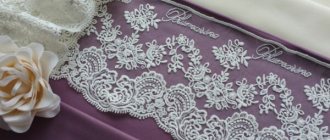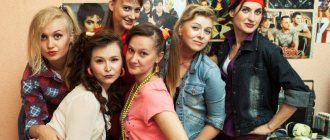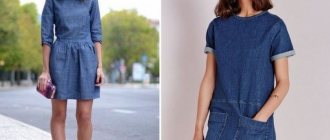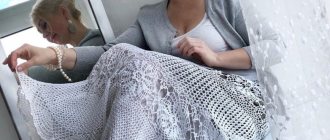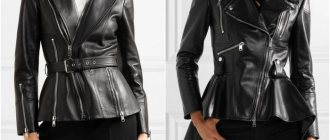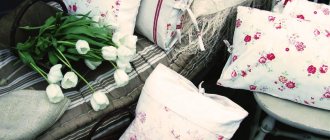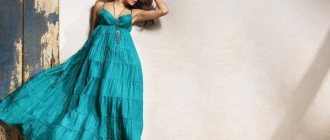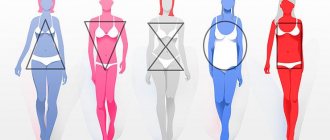What makes the era special?
The style of the 90s can hardly be called a separate direction. In fact, young people simply began to have a new attitude towards fashion and the selection of wardrobe items. Designers created them according to a different principle.
Unlike the 80s, during this period it became important to be yourself. Particular attention was paid to the inner world, individuality as such and the creation of one’s own style. It was during this era that image makers and stylists began to appear. Magazines published numerous tips on exactly how to emphasize your own individuality.
Characteristics
In the 90s, denim wardrobe items began to become especially popular. Everyone, without exception, wore such clothes. It's not just about jeans. Overalls, skirts and sundresses, vests and jackets, as well as shorts have gained popularity.
Just then, the characteristic sets of denim clothing of the 90s appeared, consisting of a jacket, jacket and trousers. It was customary to wear these wardrobe items exclusively together. Denim was also used to create shoes, all kinds of hats and bags. It is not surprising that the fashion of the nineties is often called denim.
In those years, unisex clothing became popular . Jeans were often combined with T-shirts, and preference was given to voluminous sweaters and the most comfortable shoes.
True, during the same period a certain theatricality became popular. Bright colors began to be used. And in quite large quantities. Women's fashion had precisely these features.
Particular attention was paid not to clothing as such, but to the human body. It had to be very tanned or, on the contrary, excessively prodigal. The figure is exceptionally slender, often even excessively thin.
Many fashionistas began to visit not only the gym, but also beauty salons. Plastic surgery has gained particular popularity. A kind of cult of models arose. Women began to look up to celebrities such as Cindy Crawford and Naomi Campbell.
At 90, clothes were no longer so important. It was difficult to surprise anyone with it. Therefore, many began to decorate the body. Tattoos and piercings have become popular.
Addition to clothes
Considering that sportswear was at the peak of popularity, sneakers, sneakers and light moccasins were worn with almost any outfit. Also in demand were shoes with high platforms, which were worn under leggings or short skirts, and shoes with high and thick heels.
High boots decorated with fur and boots with complex lacing were worn in the cold season.
And in the summer months, soapbox slates began to be actively used in a variety of colors, which were popular with both women and men. Moreover, they were worn not only on the beach, but also during city walks.
As for accessories, they were mandatory attributes of any clothing. The bags were bulky, resembling sacks. Young people preferred leather or fabric backpacks. At the same time, the same bags were used everywhere.
All decorations must be very large. This rule applied not only to bracelets and beads, but also to earrings. Such jewelry was made from plastic or metal, and wooden products were also fashionable. Teenagers used hoops and large elastic bands in bright colors. The photos from those years show the extent to which these numerous decorations were used.
As for precious metals, gold was especially popular, jewelry from which was also distinguished by its massiveness and volume.
Hair and makeup
Hairstyles in the nineties are a separate topic for discussion. The main attribute of any hairstyle was a large bouffant. Such styles with voluminous, varnished bangs were used both for going to work and for fashionable parties.
Perm is another fashionable attribute of that time. It was done on hair of any length by women of all ages.
The peak of the fashionable look was bleached hair, which was mercilessly dyed, achieving a bright white color.
Young people used a high ponytail, in which they tied the hair at the back or side of the head. They secured it with bright wide elastic bands.
As for makeup, here the fashion of the nineties also showed itself very clearly. The trend was arrows and bright shadows of a wide variety of colors. It was customary to paint eyelashes very thickly, and colored mascara was often used. Fashionistas drew not only arrows, but also moles.
The lips were also painted very brightly, using a lining pencil, the contours of which were fashionable to be drawn a little larger than the lips themselves. In this case, even the use of purple was completely acceptable.
But already in the late 90s, catchy and bright makeup was replaced by “smoky” Smoky Eyes. It was used even during the daytime. Lips began to be painted pale pink or left unpainted at all.
As you can see, fashion in the 90s had its own distinctive and very bright “face”. Women resorted to bright details, trying to combine catchy colorful elements and minimalism. Thanks to this, such a unique style of the late 20th century was born.
What did they wear in the nineties? Details in the video:
Development of the direction in Russia
In the 90s, what became fashionable in Russia was what was trending in European countries and America back in the mid-eighties. This was due to the fall of the Iron Curtain. Many brightly colored wardrobe items began to be imported into the country, which could only be purchased from speculators. People tried to dress in everything foreign and follow fashion.
This era is remembered by many for denim and leather mini skirts, boiled jeans, as well as sweaters with the widest possible shoulders. Women's leggings in bright colors, tracksuits, and extraordinary sweaters have become in demand. Also, electronic wristwatches appeared in the country, which appeared on almost everyone’s wrists.
Popular stylistic trends
Clothing from the distant nineties was quite diverse. Various styles were popular. The main ones should be considered in more detail.
Grunge
The founder of this trend is considered to be the Nirvana group and, in particular, its member Kurt Cobain. This group was able to make a real revolution in the field of music and had a certain influence on fashion. Fans began dressing in bulky sweaters and pants, now known as boyfriend pants. Clearly stretched cardigans, checkered shirts, massive boots, sneakers and leather jackets have also become appropriate.
Among the main features of this direction are:
- jeans;
- plaid denim;
- large voluminous clothes;
- multilayer;
- some untidiness.
Similar outfits were even seen on the catwalks. Many famous designers created clothes in the grunge style.
Minimalism
Although this trend originated in the sixties, it gained its peak of popularity in the nineties. Many stylists emphasized the simplicity of colors and shapes, as well as a certain conservatism. The cut was quite strict, and the silhouette was as simple as possible.
Among the striking examples of minimalism, it is worth highlighting the outfits of such famous brands as Calvin Klein and Donna Karan . It was these manufacturers who later placed the unisex trend on a fashionable pedestal, which became the fruit of the minimalist style.
Unlike grunge, which was popular on the streets and came to the catwalks from there, in this case the situation is completely different. Designers have done everything to ensure that people begin to prefer laconic jackets and jeans, snow-white T-shirts and tops, as well as flat shoes.
It was in this form that Monica and Rachel from the series “Friends” appeared on the screens, as well as Agent Scully from the then popular “The X-Files”.
Rave and neon
A new musical direction appeared, which was called rave. This music was characterized by endless parties and drugs. Naturally, the rave could not help but influence fashion. Acid shades, plastic and vinyl have gained popularity. Psychedelic images began to be applied to tank tops and T-shirts. Shoes were chosen on a massive platform. The hair, like the makeup, was as bright as possible.
It was quite difficult to see this trend at shows in fashion houses. It was actively used on the streets. The girls dyed their hair orange, green and blue, wore shoes with platforms up to 15 cm and clothes made of vinyl. This style could be found everywhere, even in Russia.
Sport chic
Clothes in the 90s style were leggings, which were usually worn with sneakers and all kinds of T-shirts . They were even worn under dresses and short skirts. In addition, the crop top has gained popularity. With its help, it was possible to clearly demonstrate the piercing in the navel area. As a rule, it was worn in tandem with mini skirts or jeans.
You could see sports-chic outfits not only on the catwalks, but also in the movies. At that time it was used in the vast majority of TV series for young people.
Eco style
The environment during that period deteriorated significantly throughout the world. Naturally, fashion trends have also changed. Designers began to try not to create new materials, but to recycle those that were already in use.
For example, a famous fashion designer, whose name is Martin Margiela, began altering wardrobe items that had already gone out of fashion. This idea quickly spread around the world and began to be used everywhere. Eco-style has gained popularity not only in the interior, but also in clothing.
Synthetic fabrics have almost completely ceased to be used. The choice was made of cotton and linen materials. Preference began to be given to shoes made of leather. True, it was during this period that active propaganda for the ban on natural fur began. It was increasingly replaced by artificial ones. Just in the 90s, Franco Moschino became the first to stop using animal fur when creating collections. Now many manufacturers have made this decision.
Ciao bombina, signorina cries. 90s clothing style
- Firstly, these are Mawin jeans, which were popularly called “Mavins”. It was this brand that was in great demand, because they were much cheaper than, for example, American Levi's or Rifle. “Malvina” was worn by everyone – both boys and girls. Later the brand could be anything, but the name remained the same.
- Clothes in the style of the 90s are, of course, leggings. The colors of this wardrobe item were simply incredible, some kind of cosmic neon. And the legs in them looked like two Jidai swords. Absolutely all the girls also wore leggings, even those who probably shouldn’t have done so.
- As you know, winters in our country are harsh - when it’s minus thirty outside, you can’t be particularly fashionable. And on this occasion, the hit of the season of the nineties: meet in all the market stalls of the country - striped leggings!
- Even at that time, nylon tights were very popular. Yes, not simple ones, but shiny and iridescent ones. They filled my legs insanely, slid down every second and gathered into an accordion towards the bottom. But what can you do, such a harsh fashion was in Russia in the nineties.
- Clothing 90 is a style for those whose life motto is the phrase “beauty requires sacrifice.” Remember angora sweaters, which certainly had guipure inserts, embroidery and beads? If you want to be fashionable, you will have to choose the most nuclear color and endure the fact that the fluff never stops crawling out of the product and irritating you with its penetration into your ears, mouth, nose and eyes. Although the sweaters were very cute.
- “Leather jackets” are not only clothes in the style of the 90s, but also a fashion trend of the last couple of years. True, now a good leather jacket can be bought in almost any shopping center, but in the nineties this thing was the ultimate dream of all girls and boys.
- Of course, as in any decade, special skirts and dresses were in fashion. The style of the 90s was distinguished by rebellion and excessive sexuality, which girls did not hesitate to demonstrate both at night discos and in daylight at work. For example, an unrealistically short elastic skirt simply had to be in the wardrobe of every fashionista. Often it was black, but someone managed to get purple. As soon as you took a step in such a skirt, it immediately turned into a subtle belt. This fact made the men very happy. Now the elastic skirt is back in fashion, by the way.
- Also, everyone, from children to old people of any gender, wore tracksuits with the Adidas inscription proudly displayed on them. Later this inscription became Abibas and even Adibas.
- The real hit of the 90s is not the song of the group “Hands Up” at all, but a Boys (or BOSS) sweater with an intricate pattern that is very reminiscent of grandma’s carpet.
- A dress in style 90 is a kind of very narrow tube of fabric, which was very difficult to climb into, and if it was possible, then the chance of getting back out was extremely small. Also dresses in the style of the 90s are:
- A knee-length dress with incredibly huge shoulder pads of about thirty centimeters is an option for business ladies.
- Everything denim was very fashionable: jackets, vests, bags, sneakers, skirts and even dresses. Sometimes there were fashionistas who managed to wear all the denim elements of their wardrobe at once.
- Velvet bodycon dresses with long sleeves in burgundy, lilac, black, purple or metallic.
Characteristic wardrobe items
Certain clothes became iconic during this period. It is from this that one can recognize the style characteristic of that time.
Business image
The look of a businesswoman can most easily be described by the image of Agent Scully from the previously mentioned series “The X-Files”. Long jackets with large shoulders, short skirts and the simplest, straight trousers were appropriate. Ladies wore silk shirts and rather voluminous coats.
Casual look
In the 90s, women wore dresses in the so-called lingerie style, as well as sheath style . Sundresses in a minimalist style were also popular. They were short and square in shape.
Among the iconic clothes, it is worth whitewashing T-shirts and T-shirts with a peculiar fringe. To create it, the lower part of the product was cut into strips. In addition, many girls chose crop tops and T-shirts with images of various celebrities. For example, quite often one could see outfits with photos of the main characters of the movie Titanic, which everyone without exception watched at that time.
Among wardrobe items, bright leggings deserve special attention. Perhaps almost every fashionista had them.
In addition, the following clothes became iconic:
- the most loose and shortened sweater models;
- knitted jackets and dresses;
- traditional high-waisted trousers;
- bell-bottom pants;
- trousers with ethnic or animal print;
- overalls, sewn from leather and denim;
- Numerous denim clothing.
In addition, many leather wardrobe items were used. These were skirts, raincoats, vests, jackets, as well as shorts and trousers.
Accessories and shoe models
Particularly popular were massive shoe models equipped with tractor-type soles, as well as boots and shoes with stable, fairly thick heels. Adherents of the grunge style preferred ankle boots. Sneakers and sneakers also became popular during that period. True, if in America they wore branded shoes, then in the post-Soviet space, Chinese counterfeits were most often found.
Among the most frequently used accessories are chokers, as well as thin chains and large hoop earrings.
1990s style
In 1989 the Berlin Wall was destroyed, and in 1991 the Soviet Union collapsed. The end of the twentieth century was a period of radical changes in the political systems of different countries. Fashion also changed, it constantly evolved, turning into a gigantic industry that affects the world around us with the help of communication technologies - television and the Internet. The passion for fashion brands has made people realize that fashion is not only about things, but rather about information in and about themselves.
- General features of the era
In the 1990s, advertising, media, and books encouraged people to “be yourself.” This slogan became the slogan of advertising campaigns for Calvin Klein and Hugo Boss perfumes. The main things in fashion have become individuality, reflection of the inner self, and personal style. At the same time, the profession of image maker has become in demand, not only among celebrities, but also among representatives of the middle class. Designers and stylists on the pages of glossy magazines regularly gave advice on how to emphasize individuality and create a unique image.
The most popular in street fashion of all social classes has become clothes that are close to unisex - jeans, T-shirts, loose trousers, sweaters, comfortable shoes - flat shoes or sneakers. Clothes in this style were offered by large companies, mainly Italian and American: Benetton, Guess, Gap, Marc O'Polo, Banana Republic. But functionality and convenience paradoxically coexisted with deliberate theatricality and colorfulness.
The emphasis has largely shifted from clothing to appearance. Tanning or paleness, a slim figure have become important elements of a fashionable image. To the numerous sports clubs that arose back in the 80s, beauty salons and aesthetic surgery were added. Supermodels, through the efforts of magazines and television, have become role models, while simultaneously demonstrating all the achievements of the fashion industry.
- Attention to the human body
By the end of the twentieth century, another interesting trend emerged: the body itself became the subject of fashion. Clothing, even the most bizarre, no longer surprised sophisticated viewers, so designers turned to the ancient arts of body decoration: makeup, piercing, tattoos. They have become popular not only among women, but also among men. The line between fashion design and fine art gradually blurred, artists began to use the human body instead of canvases, and fashion designers began to dress clients in paintings. This defined a new view of the human body.
Alexander McQueen used pressed leather in his collections for Givenchy, creating outfits that perfectly followed the contours of the human body. Issey Miyake transformed plastic into a kind of second skin. Jean-Paul Gaultier used elastic materials that also looked like a second skin on the body. The dress from the spring-summer 1996 collection was made of blue nylon mesh with a moire pattern that follows the contours of the human body. Gaultier created using images from various fields of art, including music. To create the spring-summer 1990 collection, he used the ideas of the American artist Richard Lindner. The central theme of the artist’s work was people reduced to the state of dolls. The women he depicted in corsets were especially impersonal sexuality, a combination of aggression and humility.
Vivienne Westwood, like Gaultier, was looking for an expression of a new style of femininity. The strange combination of classic underwear with metal zippers became a hallmark of her designs in the 90s.
In the 1980s, fashion offered revolutionary trends: underwear turned into outerwear, which could not but surprise. However, by the end of the 1990s, this style also became familiar. Such models were offered by Tom Ford for Gucci and Jean-Paul Gaultier.
Rei Kawakubo broke the fashion rules that had developed over a century in a special way: she sewed down pillows inside her outfits, which formed irregularly shaped reliefs. In the spring of 1997, the Comme des Garsons advertising campaign stated: “Before you is something that you have never seen before, something that has never been created before; new discoveries, facing the future, liberated and full of life.” At the fall-winter 1994 show, Rae presented a dress that looked worn. The outfit was given a “shrunken” look, the free part was twisted in such a way that lumps were formed, and the yarn came out in places. The designer wanted to show clothes that give a depressing impression of anxiety and tension.
- Grunge
The founder of grunge in the 90s was the group Nirvana. Kurt Cobain, who revolutionized the music world, created a unique trend. His followers, including young girls, donned oversized sweaters and baggy men's trousers, demonstrating indifference to fashion and catwalk trends. The main features of the trend were untidiness, oversize, layering, checks and denim. Fans of the style wore huge flannel shirts with outstretched elbows, faded T-shirts, torn jeans, biker jackets, worn-out sneakers and massive heavy boots. In part, grunge was reminiscent of the hippie era, but was completely devoid of the romance of that style.
Street grunge fashion was traditionally followed by runway fashion. The closest thing to this style was the creator of punk rock, Vivienne Westwood, who for several seasons praised Cobain's careless aesthetics. Grunge was studied and canonized by Marc Jacobs, who was the first to present a collection of wrinkled dresses, asymmetrical faded T-shirts, plaid shirts and deliberately sloppily knitted sweaters. At that time, Jacobs worked as an art director at Perry Ellis and grunge brought him worldwide fame. Following him, the young designer Anna Sui began to use grunge street fashion, and then such masters as Karl Lagerfeld and Christian Lacroix presented outfits of this style.
The stars also liked the grunge aesthetics. The personification of the direction, first of all, was Kurt Cobain's wife, Courtney Love. Naomi Campbell combined this style with luxury sets. Demi Moore in the cult film “Ghost” wore oversized jeans, elongated T-shirts and worn-out sneakers. The heroes of the popular youth film “The Faculty” with Elijah Wood demonstrated their love for grunge culture. Julia Roberts in Pretty Woman wore short, ripped tops, heavy boots, and asymmetrical skirts before her makeover.
On the streets and catwalks of Great Britain, grunge merged with New Age style. The music of this direction is characterized by formlessness, fluidity, cosmic motifs and synthesized electronic sounds (Brian Eno, Klaus Schulz). In clothing, New Age manifested itself in the free mixing of motifs from different cultures and styles within one costume. Unlike grunge, this style was created deliberately to emphasize the spirituality of the image. The “White Collection” by Rifat Ozbek had a great influence on the formation of the New Age: a romantic interpretation of urban Turkish costume - capes, bustiers, scarves, trousers, completely made in white.
- Minimalism
The 90s saw a second wave of minimalism. Many designers have chosen purism, simplicity of shapes and colors. Helmut Lang and Jil Sander were the first to present such collections: they focused on laconic cuts, simple silhouettes and high-quality fabrics. Then Donna Karan and Calvin Klein began to preach minimalism. Calvin Klein later canonized an extreme form of minimalism - unisex, which eventually transformed into androgyny.
From the catwalks, minimalism came to street fashion: skinny jeans, simple white tops and T-shirts, flat shoes, laconic jackets and an almost complete absence of accessories became the uniform. Of the stars, Gwyneth Paltrow and Jennifer Aniston have most adopted this trend, including in their role as Rachel from Friends. The Swedish group Roxette, whose popularity peaked in the mid-90s, replaced grunge with minimalism. In Pretty Woman, Julia Roberts began wearing minimalistic outfits after Richard Gere's character worked on her style. Sharon Stone in the cult “Basic Instinct” became an icon of minimalism in the mid-90s.
- Rave and neon
In the 90s, after grunge, rave appeared in music - electronic dance music combined with unbridled fun, endless parties and synthetic drugs. The groups Prodigy and Scooter became cult rave performers.
After the emergence of the music trend, a new style was formed: bright acid colors, vinyl, plastic, neon, micromini, shoes with huge platforms, T-shirts with psychedelic prints, crazy hairstyles and makeup. This trend practically did not leak onto the catwalks, but it was very popular in street fashion and among the stars. At that time, Gwen Stefani appeared in public with blue hair, incredible styling, plush and rubber skirts and sneakers with a 15-centimeter platform. The rave trend was demonstrated by Luc Besson in the film The Fifth Element. Milla Jovovich appeared on camera in neon suits, plastic and vinyl skirts, and incredible shoes. Her hair was a cosmic carrot color.
- Sporty chic
In the mid-90s, Sporty chic became popular. Leggings were now an iconic wardrobe staple: they were paired with high-top sneakers, shiny tanks, and layered over skirts and dresses. A style-forming element was also a cropped top that exposed the belly, which was worn with jeans and high-waisted skirts, shirts, jackets and oversize jackets.
Sports chic also came to the catwalks: models in windbreakers and stiletto heels appeared in the collections of Marc Jacobs, Chanel, and Dior. Adherents of the trend were members of the cult group Spice Girls and singer Gwen Stefani from No Doubt. In the 90s, many youth series were released where sporty chic was one of the main directions - for example, in Beverly Hills 90210 and Charmed.
- Ethno
The ethnic theme remained popular in the 90s. Indian, Chinese, Japanese motifs appeared in the collections of Valentino Garavani, Alexander McQueen, John Galliano, Gianni Versace, Domenico Dolce and Stefano & Gabbana. Romeo Gigli created colorful variations on the themes of costumes and scenery for the performances of the Russian seasons in Paris and London of 1907-1914. John Galliano began working for the Christian Dior fashion house in 1996. He regularly drew inspiration from historical and ethnic costumes.
- Eco-clothing
The end of the millennium was marked, among other things, by a sharp deterioration in the ecology of the planet; many industries were considered harmful and dangerous. Caring about the cleanliness of the environment, people turned to recycling used materials, looking for an opportunity to use them to produce clothing. An interesting solution to the problem was proposed by the Belgian fashion designer Martin Margiela, who made his debut in 1989 in Paris. For his new collections, he did not order new fabrics, but altered old models, which, in his opinion, had lost their relevance. So he created a kind of vicious cycle that denies the very idea of the fashion industry, constantly abandoning old things for the sake of new outfits. In the 1990s, his clothing recycling proposal gained widespread recognition.
Attention to environmental issues prompted designers to use undyed linen and hemp fibers for sewing models. Englishwoman Helen Storm presented outfits repurposed from old clothes in her 1992 “Second Life” collection. Her compatriot Katherine Hamnet worked exclusively with environmentally friendly fabrics, which were supposed to be worn with comfortable shoes - flat leather sandals or soft boots made of thick leather.
Since the early 90s, the “green” movement began to gain strength, fighting against the use of natural fur in clothing. Conservationists threw tomatoes at women in fur coats and doused them with oil paints. Models and stars have stated that they will no longer wear real fur. Designers began working mainly with synthetic fur. Franco Moschino was the first: back in 1989, he presented a fur coat made from teddy bears.
By the end of the decade, the “green” protests slowed down, as environmentalists proved that the use of synthetic materials is much more dangerous for nature than the reasonable use of natural ones. Collections in which fur played a significant role again appeared on the catwalks.
- 90s in Russia
Russia in the 90s had its own views on fashion. After the collapse of the USSR, a huge number of people began to travel to Turkey to buy clothes. In our country, markets gained popularity, while most stores stood half empty. At that time, many counterfeits of well-known brands appeared - like abibas, dorce & gabana, etc. Russian girls wore leggings made of shiny material, which were popular outside the country in the 80s. Also popular among post-Soviet fashionistas were voluminous stretched sweaters, including angora ones, miniskirts, pleated skirts, sneakers, and denim jackets. The girls wove baubles from beads and floss.
In the period from 1994 to 1998, the world's main glossy magazines in Russian appeared in Russia - Cosmopoliten, Elle, Harper's Bazaar, Vogue. Now, in post-Soviet times, it has become possible for people to get acquainted with world fashion trends.
Modern vision
Despite the fact that this significant era of change has long been called one of the tasteless, today this stylistic trend is extremely popular. Already in 2012, designers began actively using elements from such a controversial period when creating new collections.
Initially, exclusively neon shades came into fashion, but a year later grunge gained popularity. True, complete copying of Nirvana was already rare. A certain eclecticism was introduced into this direction. Sweaters with rough knitting and lace elements were combined with rather rough boots. This trend has been in demand for several years.
Sometimes designers use rave, sport-chic and minimalist details. It is worth saying that the last two styles are constantly in fashion and have already begun to be considered universal.
Now elements of the 90 era are extremely popular. It's increasingly common to see shoes with wide heels and square toes, as well as crop tops and mini skirts. What can we say about high-waisted jeans? Perhaps every girl has them in her wardrobe.
Each designer sees this period in his own way. Some focus specifically on minimalism, creating a special emphasis on simplicity and rigor. Others pay attention to variegation and brilliance. In any case, such outfits have a special look. They were appropriate in the nineties and remain in demand to this day. Many young girls who were born in the new millennium are now actively using elements of that hard time when creating an original image. It is worth noting that when using details that were popular twenty years ago, the result is an incredibly interesting and bright bow that simply cannot be ignored.
90s style in the 21st century
The 1990s are often considered one of the worst and most tasteless fashion periods. To comprehend the style of this decade and fully return it to the catwalks, designers first had to largely forget this trend.
The 90s became a real trend only in the spring-summer 2012 season. Many fashion designers focused on deliberately bright multi-colored prints on T-shirts and leggings, and exposed the belly on tops with a high-waisted skirt or trousers. Denim in all its forms has become trendy, including high-waisted jeans and “varenki” jeans. Blouses with a clear square shoulder line were also fashionable. Braided bracelets made of threads, beads, and elastic bands appeared in the collections. The 90s style was presented by Yves Saint Laurent, Nina Ricci, Dsquared2, Badgley Mischka.
In the spring-summer season of 2013, many designers exploited the grunge style. Untidyness, oversize, layering, checks, denim, as well as bold eclecticism - elegant lace combined with coarse knitting, transparent chiffon combined with thick denim - have again become fashionable features. Grunge appeared in varying proportions at Saint Laurent, 3.1 Phillip Lim, Ashish, Anna Sui, Dries Van Noten and Acne. Grunge hairstyles have also become popular. Ashish at the spring-summer 2013 show offered a hairstyle of unkempt hair, carelessly gathered with a wide white elastic band into a high bun. Vivienne Westwood presented this trend in a more theatrical way in the Vivienne Westwood Red Label collection: neon accessories and makeup were complemented by large hair clips with artificial flowers. These bouquet clips were complemented with perhydrol blonde. The return to fashion of large hair bands was enjoyed by celebrities: Sienna Miller, Cara Delevingne, Uma Thurman, Catherine Zeta-Jones, Selena Gomez, Katy Perry, Whitney Port, Mary-Kate were seen with messy buns and ponytails tied with a wide elastic band. Olsen, Miranda Kerr, Jessica Alba, Freida Pinto.
Minimalistic collections for the spring-summer 2013 season were presented by Celine, Jil Sander, Calvin Klein and Marni. Rave showed itself primarily at Comme des Garçons, but also in the shiny neon raincoats of Burberry Prorsum, psychedelic sparkling prints of Anthony Vaccarello, glossy fabrics and abstractions of Christian Dior. Sports-chic outfits were presented by the Sportmax brand; cropped tops appeared in the collections of Balmain, Louis Vuitton and Costume National. Moncler Gamme Rouge dressed the models in shorts and sneakers, and Lacoste traditionally presented minimalism in its purest form.
In the fall-winter 2013/2014 season, the main trends from the 90s were massive cropped jackets, voluminous fur, oversize, funny knitted hats, layering, and backpacks. The wide heel that was popular in the 90s has returned to fashion, as has the combination of shoes with thick socks (Viktor & Rolf, Lanvin, Rodarte, Marc by Marc Jacobs). Phillip Lim widely used the style of the 90s: voluminous T-shirts and sweaters, miniskirts and patent leather jackets, leopard jackets and skirts with shirts tied at the waist.
In the spring-summer season 2014, cropped tops are especially noticeable among the characteristic features of the 90s. They are presented in the collections of Lela Rose, Tracy Reese, 3.1 Phillip Lim, Zimmermann. House of Holland was inspired by the 90s and Baz Luhrmann's film Romeo + Juliet.
